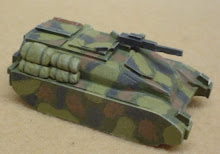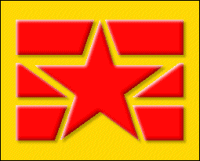A Plan for a Preemptive Strike on the United States by the British Dominion of Canada, circa 1921
In December 2005, the Washington Post published a quixotic article entitled Raiding the Icebox. The piece introduces readers to U.S. War Plan Red, the little-known 1930 plan to conquer Canada. More sardonic than serious, the article acted mostly as a holiday diversion from the quagmire in Iraq: "Invading Canada won't be like invading Iraq: When we invade Canada, nobody will be able to grumble that we didn't have a plan." When interviewed, both Canadians and Americans took it as a joke, competing for the cleverest quip. Winnipeg mayor Sam Katz defiantly vows to the American enemy: "It will be like Napoleon's invasion of Russia."
Americans routinely joke about conquering Canada. But these plans are no joke. As a loyal, self-governing Dominion in the British Empire, Canada served as a proxy for American tensions with Britain throughout the 19th century. American troops invaded Canada during both the American Revolution (!) and the War of 1812. Significant border disputes existed until the 1850s, covering tens of thousands of square miles. Tensions rose during the American Civil War, when Confederates and Irish nationalists looked to Canada as a shelter, launching pad, and target. Even seemingly unrelated matters such as the Venezuelan boundary dispute of 1895 threatened to flare up into conflict between Britain and the United States.
As the twentieth century dawned, tensions lessened as Anglo-American interests coincided more and more. Yet, until the 1920s, there was a real risk that the Anglo-Japanese alliance would draw Canada into war with the United States. The British were quite serious about their alliance with Japan, inviting Japan into the inner circle of the Allied Powers in the Paris peace talks ending World War I. The alliance bound Britain to neutrality in the event of war between Japan and one other power, and to military support of Japan in the event of war between Japan and two other powers. As World War I demonstrated, overlapping treaties can have a cascading effect.
Strategic thinking tends to lag behind strategic reality. Despite the end of the Anglo-Japanese treaty in 1921, the US developed War Plan Red in the 1920s to address a possible war with the British Empire. Conversely on the Canadian side, James Sutherland "Buster" Brown prepared for a war with the United States. Thus was hatched Canadian Defense Scheme No. 1.
To counter the seemingly overwhelming American military advantage, "Buster" Brown envisioned a preemptive strike against the United States. Canadian troops would mobilize quickly and attack with little warning, relying on surprise to penetrate American soil as far south as Oregon. Of course, the massively outnumbered Canadian forces could not hope to hold on to the captured territory. So they would begin a strategic withdrawal, destroying bridges, roads, and factories as they went. Thus, it would be American territory, rather than Canadian, that would be used for strategic depth. It would be American industry, farmland, and infrastructure that was destroyed, all of which would hamper American efforts to bring troops to the Canadian border. The gamble, then, was that Imperial forces would arrive to hold the line by the time Canadian forces had retreated back into Canada.
Clearly, Canadian Defense Scheme No. 1 was both daring and risky. It relies to a certain extent on US forces being caught off guard, a naïve assumption given the proximity. Ultimately, Defense Scheme No. 1 and its American counterpart faded away as Anglo-American relations continued to improve. War Plan Red was one of two dozen color-coded plans developed by the US military, ranging from major world wars to the invasion of Caribbean nations (Gray). In contrast, Canada's potential enemies were much fewer. Defense Scheme No. 2 addressed a possible war with Japan, in case the Pacific realignment drew Britain into war with its former ally, and No. 3 and No. 4 simply planned the dispatch of Canadian troops to aid British forces in European and colonial wars2.
American War Plan Red was declassified in the 1970s, but quickly became a footnote in comparison to Black (Germany) and Orange (Japan). Military historians seized on Orange, in particular, as a sign of the times, envisioning super-dreadnought battleships steaming to the Philippines (then an American colony) to engage in a fleet action with the Imperial Japanese Navy, sixteen-inch guns blazing. Canadian Defence Scheme No. 1 fell into even greater obscurity, not least because it was largely an internal army discussion, "not fully disclosed to the Government." War Plan Red resides in the National Archives of the United States, while Defense Scheme No. 1 lives at Queens University, in a collection of James Sutherland Brown's papers. An excerpt was published in a 1965 five-volume academic study of Canada's defense history, which as the sole published copy seems to be the source of most further inquiry (although many sources cite the James Sutherland Brown papers collection directly).
The well-known War Plan Red is available online. Interestingly, it was located, digitized, and posted to Usenet in 1995 by Floyd Rudmin, who was then at Queens University, where the full Defense Scheme No. 1 is located. I guess that University is just a hothead of Canadian resistance to American domination! Until and unless I make my way to Queens University someday to locate the complete copy, I present here the partial plan that is available in published works. Canadian Crown Copyright lasts fifty years, so the Defense Scheme is now in the public domain.
Some great games of this scenario by MrF'S Gaming
•2 - Stone Falls p2
•3 - USA Strikes Back p1
•4 - USA Strikes Back p2
In December 2005, the Washington Post published a quixotic article entitled Raiding the Icebox. The piece introduces readers to U.S. War Plan Red, the little-known 1930 plan to conquer Canada. More sardonic than serious, the article acted mostly as a holiday diversion from the quagmire in Iraq: "Invading Canada won't be like invading Iraq: When we invade Canada, nobody will be able to grumble that we didn't have a plan." When interviewed, both Canadians and Americans took it as a joke, competing for the cleverest quip. Winnipeg mayor Sam Katz defiantly vows to the American enemy: "It will be like Napoleon's invasion of Russia."
Americans routinely joke about conquering Canada. But these plans are no joke. As a loyal, self-governing Dominion in the British Empire, Canada served as a proxy for American tensions with Britain throughout the 19th century. American troops invaded Canada during both the American Revolution (!) and the War of 1812. Significant border disputes existed until the 1850s, covering tens of thousands of square miles. Tensions rose during the American Civil War, when Confederates and Irish nationalists looked to Canada as a shelter, launching pad, and target. Even seemingly unrelated matters such as the Venezuelan boundary dispute of 1895 threatened to flare up into conflict between Britain and the United States.
As the twentieth century dawned, tensions lessened as Anglo-American interests coincided more and more. Yet, until the 1920s, there was a real risk that the Anglo-Japanese alliance would draw Canada into war with the United States. The British were quite serious about their alliance with Japan, inviting Japan into the inner circle of the Allied Powers in the Paris peace talks ending World War I. The alliance bound Britain to neutrality in the event of war between Japan and one other power, and to military support of Japan in the event of war between Japan and two other powers. As World War I demonstrated, overlapping treaties can have a cascading effect.
Strategic thinking tends to lag behind strategic reality. Despite the end of the Anglo-Japanese treaty in 1921, the US developed War Plan Red in the 1920s to address a possible war with the British Empire. Conversely on the Canadian side, James Sutherland "Buster" Brown prepared for a war with the United States. Thus was hatched Canadian Defense Scheme No. 1.
Analysis
Knowing that Canada suffered from a ten-to-one manpower disadvantage against the United States, "Buster" Brown's plan relied on strategic surprise and lightning movements. Canada could not hope to win a one-on-one war with the United States, so any Canadian defense plan had to rely on troops from the British Empire for military parity. Yet, in the age before air transport, any aid from Britain or her colonies would take weeks or months to arrive by sea. Canada had precious little strategic depth with which to undertake a defensive war, as the bulk of its population, industry, and rail lines were located near the American border. Indeed, the American War Plan Red relies on the proximity of Canadian resources to project a rapid and successful conquest of Canada.To counter the seemingly overwhelming American military advantage, "Buster" Brown envisioned a preemptive strike against the United States. Canadian troops would mobilize quickly and attack with little warning, relying on surprise to penetrate American soil as far south as Oregon. Of course, the massively outnumbered Canadian forces could not hope to hold on to the captured territory. So they would begin a strategic withdrawal, destroying bridges, roads, and factories as they went. Thus, it would be American territory, rather than Canadian, that would be used for strategic depth. It would be American industry, farmland, and infrastructure that was destroyed, all of which would hamper American efforts to bring troops to the Canadian border. The gamble, then, was that Imperial forces would arrive to hold the line by the time Canadian forces had retreated back into Canada.
Clearly, Canadian Defense Scheme No. 1 was both daring and risky. It relies to a certain extent on US forces being caught off guard, a naïve assumption given the proximity. Ultimately, Defense Scheme No. 1 and its American counterpart faded away as Anglo-American relations continued to improve. War Plan Red was one of two dozen color-coded plans developed by the US military, ranging from major world wars to the invasion of Caribbean nations (Gray). In contrast, Canada's potential enemies were much fewer. Defense Scheme No. 2 addressed a possible war with Japan, in case the Pacific realignment drew Britain into war with its former ally, and No. 3 and No. 4 simply planned the dispatch of Canadian troops to aid British forces in European and colonial wars2.
American War Plan Red was declassified in the 1970s, but quickly became a footnote in comparison to Black (Germany) and Orange (Japan). Military historians seized on Orange, in particular, as a sign of the times, envisioning super-dreadnought battleships steaming to the Philippines (then an American colony) to engage in a fleet action with the Imperial Japanese Navy, sixteen-inch guns blazing. Canadian Defence Scheme No. 1 fell into even greater obscurity, not least because it was largely an internal army discussion, "not fully disclosed to the Government." War Plan Red resides in the National Archives of the United States, while Defense Scheme No. 1 lives at Queens University, in a collection of James Sutherland Brown's papers. An excerpt was published in a 1965 five-volume academic study of Canada's defense history, which as the sole published copy seems to be the source of most further inquiry (although many sources cite the James Sutherland Brown papers collection directly).
The well-known War Plan Red is available online. Interestingly, it was located, digitized, and posted to Usenet in 1995 by Floyd Rudmin, who was then at Queens University, where the full Defense Scheme No. 1 is located. I guess that University is just a hothead of Canadian resistance to American domination! Until and unless I make my way to Queens University someday to locate the complete copy, I present here the partial plan that is available in published works. Canadian Crown Copyright lasts fifty years, so the Defense Scheme is now in the public domain.
Some great games of this scenario by MrF'S Gaming
•2 - Stone Falls p2
•3 - USA Strikes Back p1
•4 - USA Strikes Back p2



















































No comments:
Post a Comment